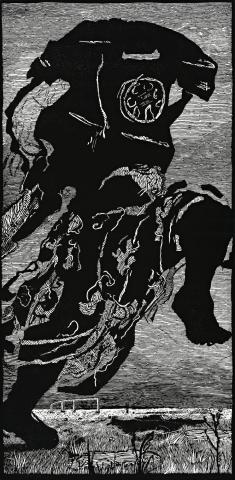TELEPHONE LADY, 2000
WILLIAM KENTRIDGE
linocut on stretched canvas
205.0 x 101.0 cm
signed and numbered verso: 3/9 / WKentridge
Annandale Galleries, Sydney (label attached verso)
Private collection, Sydney
Versions of this work on canvas and on paper have been exhibited at the following:
William Kentridge Five Themes: San Francisco MOMA, 14 March – 31 May 2009 then touring to: Modern Art Museum of Fort Worth, United States of America; Norton Museum of Art, West Palm Beach, United States of America; Museum of Modern Art, New York, United States of America; Albertina, Vienna, Austria; Israel Museum, Jerusalem; Stedelijk Museum, Amsterdam
A Universal Archive – William Kentridge as Printmaker, Hayward Gallery, London, touring exhibition through UK, 2013 – 2014
Hecker, J., William Kentridge – Trace: Prints from the Museum of Modern Art, Museum of Modern Art, New York, 2010, pl. 12 (illus., another example printed on paper)
Krauss, R., Malbert, R., and McCrickard, K., A Universal Archive: Kentridge as Printmaker, Hayward Gallery, London, 2012, p. 64 (illus., another example)
McCrickard, K., William Kentridge, Tate Publishing, London, 2012, p. 38 (illus., another example printed on paper)
Another version (printed on paper) is in the collection of the Museum of Modern Art, New York
William Kentridge is a South African visual artist and creator and director of animated films, operas and plays. His vast oeuvre which touches on life, death and everything in between resonates strongly with a local and international audience, making him one of the world's most celebrated contemporary artists. Born in Johannesburg and of Lithuanian-Jewish descent, Kentridge grew up in a politically active family; both his parents were leading civil rights lawyers for the anti-apartheid movement and his father represented Nelson Mandela and other Congress leaders in 1958 during the Treason Trial. Growing up in such a turbulent period of modern history has greatly influenced Kentridge's artistic practice as he saturates his work in political and social commentary, as evident in Telephone Lady.
In the picture on offer, the giant anthropomorphic phone fills the canvas. Her legs stomp over a pond as the folds of her dress swirl over her legs in either a blind panic, or possibly in a dance- 'over the land, high-stepping in a possible performance of the Zulu ingoma or indlamu stomps'.1 A fence divides the grassy terrain in the background providing evidence of human occupation, but otherwise the landscape is barren and devoid of life. The lines that appear in the sky and in folds of the woman's dress create a sense of movement, lifting the image off the canvas. As the viewer's eye moves upwards, the female form ends at the waist as the torso and head is replaced by an old fashioned Bakelite telephone. Large and cumbersome, the telephone consumes the woman's identity, robbing her of her sight and her voice, echoing the issue of freedom of speech during the apartheid regime.
This theme of metamorphosis, which is also evident in the closely related Walking Man,2 was explored in response to the Truth and Reconciliation Commission after the apartheid regime was dissolved in 1994. In Ubu and the Procession series, anthropomorphic figures and human silhouettes march onwards in a 'road to nowhere' referencing the devastating effect of the apartheid and the displacement of people all over the world. This subject also has its origins in Ovid's Latin poem Metamorphoses. In Ovid's myths, many of the characters are transformed from their human form into an animal or inanimate object. Some transform to escape violent behaviour whilst others are transformed as a punishment by the gods.
Kentridge first began creating prints in the 1970s and has made more than five hundred prints including etchings, screenprints and linocuts. The linocut was a popular medium used in South Africa as a tool for political ideology against apartheid oppression; '... linoleum-cut printing 'a medium whose economy of means and capacity for bold black-and-white line work has long appealed to activist art centres throughout South Africa'.3 The linocut is not only a cost effective medium of mass reproduction, it is also in opposition to the traditional European canon of oil paint and 'pretty pictures' which Kentridge has shied away from; 'perhaps working away from here in some European or rural haven, I would be able to paint apples and colours, but I doubt it'.4
1. McCrickard, K., William Kentridge, Tate Publishing, London, 2012, p. 39
2. Deutscher and Hackett sold an example of this linocut in November 2013
3. Hecker, J., William Kentridge -Trace: Prints from the Museum of Modern Art, Museum of Modern Art, New York, 2010, pp. 13-14
4. Kentridge, quoted in McCrickard, op. cit., p. 7
CASSI YOUNG
